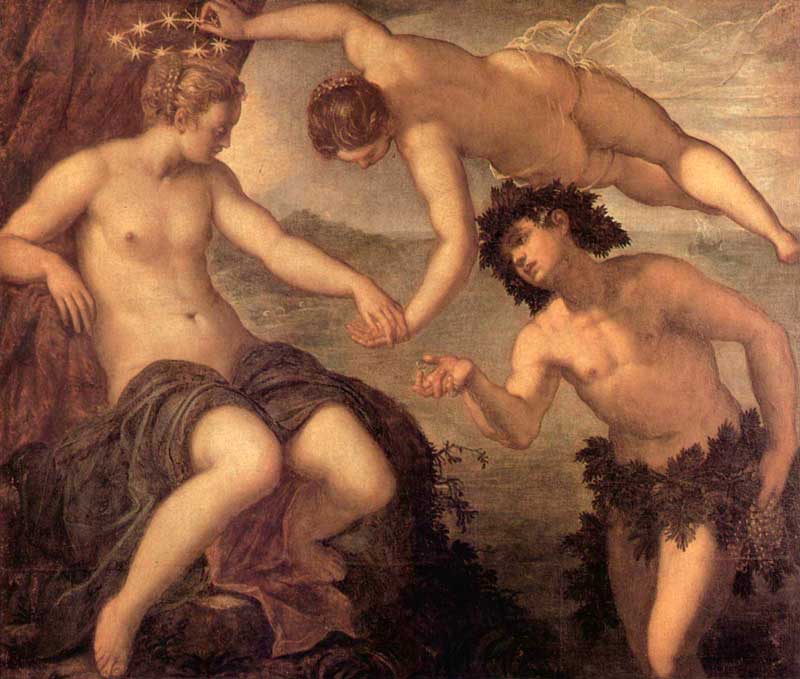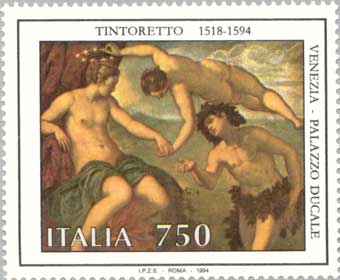.

Ariadne, Venus and Bacchus, Tintoretto 1576, Sala di Anticollegio, Palazzo Ducale, Venice
BACCHUS AND ARIADNE
(TINTORET)
HIPPOLYTE ADOLPHE TAINE
It is more difficult for me to speak to you of the Venetian painters than of any others. Before their pictures one has no desire to analyze or reason; if one does this, it is by compulsion. The eyes enjoy, and that is all: they enjoy as the Venetians enjoyed in the Sixteenth Century; for Venice was not at all a literary or critical city like Florence; there painting was nothing more than the complement of the environing pleasure, the decoration of a banqueting-hall or of an architectural alcove. In order to understand this you must place yourself at a distance, shut your eyes and wait until your sensations are dulled; then your mind performs its work....
There are certain families of plants, the species of which are so closely allied that they resemble more than they differ from each other: such are the Venetian painters, not only the four celebrities, Giorgione, Titian, Tintoret, and Veronese, but others less illustrious, Palma "il vecchio," Bonifazio, Paris Bordone, Pordenone, and that host enumerated by Ridolfi in his Lives, contemporaries, relatives, and successors of the great men, Andrea Vicentino, Palma "il giovine," Zelotti, Bazzaco, Padovinano, Bassano, Schiavone, Moretto, and many others. What first appeals to the eye is the general and common type; the individual and personal traits remain for a time in shadow. They have worked together and by turns in the Ducal Palace, but by the involuntary concord of their talents their pictures make an harmonious whole.
Bacchus and Ariadne.
Tintoreto
At first our eyes are astonished; with the exception of three or four halls, the apartments are low and small. The Hall of Council of the Ten and those surrounding it 1 are gilded habitations, insufficient for the figures that dwell therein; but after a moment one forgets the habitation and sees only the figures. Power and voluptuousness blaze there, unbridled and superb. In the angles nude men, painted caryatides, jut out in such high relief that at the first glance one takes them for statues; a colossal breath swells their chests; their thighs and their shoulders writhe. On the ceiling a Mercury, entirely nude, is almost a figure by Rubens, but of a more gross sensuality. A gigantic Neptune urges before him his sea-horses which plash through the waves; his foot presses the edge of his chariot; his enormous and ruddy body is turned backwards; he raises his conch with the joy of a bestial god; the salt wind blows through his scarf, his hair, and his beard; one could never imagine, without seeing it, such a furious élan, such an overflowing of animal spirit, such a joy of pagan flesh, such a triumph of free and shameless life in the open air and broad sunlight. What an injustice to limit the Venetians to the painting of merely happy scenes and to the art of simply pleasing the eye! They have also painted grandeur and heroism; the mere energetic and active body has attracted them; like the Flemings, they have their colossi also. Their drawing, even without colour, is capable by itself of expressing all the solidity and all the vitality of the human structure. Look in this same hall at the four grisailles by Veronese—five or six women veiled or half-nude, all so strong and of such a frame that their thighs and arms would stifle a warrior in their embrace, and, nevertheless, their physiognomy is so simple or so proud that, despite their smile, they are virgins like Raphael's Venuses and Psyches.
The more we consider the ideal figures of Venetian art, the more we feel the breath of an heroic age behind us. Those great draped old men with the bald foreheads are the patrician kings of the Archipelago, Barbaresque sultans who, trailing their silken simars, receive tribute and order executions. The superb women in sweeping robes, bedizened and creased, are empress-daughters of the Republic, like that Catherina Cornaro from whom Venice received Cyprus. There are the muscles of fighters in the bronzed breasts of the sailors and captains; their bodies, reddened by the sun and wind, have dashed against the athletic bodies of janizaries; their turbans, their pelisses, their furs, their sword-hilts constellated with precious stones,—all the magnificence of Asia is mingled on their bodies with the floating draperies of antiquity and with the nudities of Pagan tradition. Their straight gaze is still tranquil and savage, and the pride and the tragic grandeur of their expression announce the presence of a life in which man was concentrated in a few simple passions, having no other thought than that of being master so that he should not be a slave, and to kill so that he should not be killed. Such is the spirit of a picture by Veronese which, in the Hall of the Council of the Ten, represents an old warrior and a young woman; it is an allegory, but we do not trouble ourselves about the subject. The man is seated and leans forward, his chin upon his hand, with a savage air; his colossal shoulders, his arm, and his bare leg encircled with a cnemis of lions' heads protrudes from his ample drapery; with his turban, his white beard, his thoughtful brow, and his traits of a wearied lion, he has the appearance of a Pacha who is tired of everything. She, with downcast eyes, places her hands upon her soft breast; her magnificent hair is caught up with pearls; she seems a captive awaiting the will of her master, and her neck and bowed face are strongly empurpled in the shadow that encircles them.
Nearly all the other halls are empty; the paintings have been taken into an interior room. We go to find the curator of the Museum; we tell him in bad Italian that we have no letters of introduction, nor titles, nor any rights whatsoever to be admitted to see them. Thereupon he has the kindness to conduct us into the reserved hall, to lift up the canvases, one after the other, and to lose two hours in showing them to us.
I have never had greater pleasure in Italy; these canvases are now standing before our eyes; we can look at them as near as we please, at our ease, and we are alone. There are some browned giants by Tintoret, with their skin wrinkled by the play of the muscles, Saint Andrew and Saint Mark, real colossi like those of Rubens. There is a Saint Christopher by Titian, a kind of bronzed and bowed Atlas with his four limbs straining to bear the weight of a world, and on his neck by an extraordinary contrast, the tiny, soft, and laughing bambino, whose infantine flesh has the delicacy and grace of a flower. Above all, there are a dozen mythological and allegorical paintings by Tintoret and Veronese, of such brilliancy and such intoxicating fascination that a veil seems to fall from our eyes and we discover an unknown world, a paradise of delights situated beyond all imagination and all dreams. When the Old Man of the Mountain transported into his harem his sleeping youths to render them capable of extreme devotion, doubtless it was such a spectacle that he furnished.
Upon the coast at the margin of the infinite sea, serious Ariadne receives the ring of Bacchus, and Venus, with a crown of gold, has come through the air to celebrate their marriage. Here is the sublime beauty of bare flesh, such as it appears coming out of the water, vivified by the sun and touched with shadows. The goddess is floating in liquid light and her twisted back, her flanks and her curves are palpitating, half enveloped in a white, diaphanous veil. With what words can we paint the beauty of an attitude, a tone, or an outline? Who will describe the healthy and roseate flesh under the amber transparency of gauze? How shall we represent the soft plenitude of a living form and the curves of limbs which flow into the leaning body? Truly she is swimming in the light like a fish in its lake, and the air, filled with vague reflections, embraces and caresses her.
Voyage en Italie (Paris, 1866).
FOOTNOTES:
1 Painted by Veronese and by Zelotti and Bazzaco under his direction.
--------------------------------------------------------------------------------
BACCHUS AND ARIADNE
ANONYMOUS
Titian's magnificent pictures in the Ducal Palace were, all but one, destroyed by fire the year after his death; but his impetuous rival, Tintoretto, is abundantly represented there. With regard to him, as usual, our admiration for frequent manifestations of extraordinary power is but too commonly checked and chilled by coarse, heavy painting, and the unexpressive wholly uninteresting character of many of his allegorical or celestial groups, which seem introduced merely as exercises or exhibitions of technical skill, rather than as appeals to our imagination or finer feelings.... On the whole you are again tempted to be somewhat out of conceit with Tintoretto, till you pause in the Ante Collegio, or guard-room, before a picture of his so poetically conceived and admirably wrought, indeed so pleasing in all respects, that you wonder still more at the dull, uninteresting character of so many of the others. Yes, here Il Furioso Tintoretto, leaving ostentatious, barren displays of technical power, has once again had the gentleness and patience to make himself thoroughly agreeable. Ariadne, a beautiful and noble figure, is seated undraped on a rock, and Bacchus, profusely crowned with ivy, advances from the sea, and offers her the nuptial ring; whilst above, Venus, her back towards you, lying horizontally in the pale blue air, as if the blue air were her natural couch, spreads or rather kindles, a chaplet or circlet of stars round Ariadne's head. Here, those who luxuriate in what is typical, may tell us, and probably not without truth, that Tintoretto wished to convey a graceful hint of Venice crowned by beauty and blessed with joy and abundance. Bacchus arising from the sea well signifies these latter gifts, and the watery path by which they come to her; and the lonely island nymph to whom he presents the wedding-ring, may be intended to refer to the situation and original forlornness of Venice herself, when she sat in solitude amidst the sandy isles of the lagune, aloof from her parental shores, ravaged by the Hun or the Lombard. The pale yellow sunshine on these nude figures and their light transparent shadows, and the mild temperate blue of the calm sea and air, almost completing the most simple arrangement of the colouring of the picture, are still beautiful, and no doubt were far more so before its lamentable fading, occasioned, it seems, by too much exposure to light; you feel quite out of doors, all on the airy cliffs, as you look on it, and almost taste the very freshness of the sea-breeze.
The Art Journal (London, 1857).

----
Fine Art Prints | Greeting Cards | Phone Cases | Lifestyle | Face Masks | Men's , Women' Apparel | Home Decor | jigsaw puzzles | Notebooks | Tapestries | ...
----
| Ancient Greece
Science, Technology , Medicine , Warfare, , Biographies , Life , Cities/Places/Maps , Arts , Literature , Philosophy ,Olympics, Mythology , History , Images Medieval Greece / Byzantine Empire Science, Technology, Arts, , Warfare , Literature, Biographies, Icons, History Modern Greece Cities, Islands, Regions, Fauna/Flora ,Biographies , History , Warfare, Science/Technology, Literature, Music , Arts , Film/Actors , Sport , Fashion --- |

